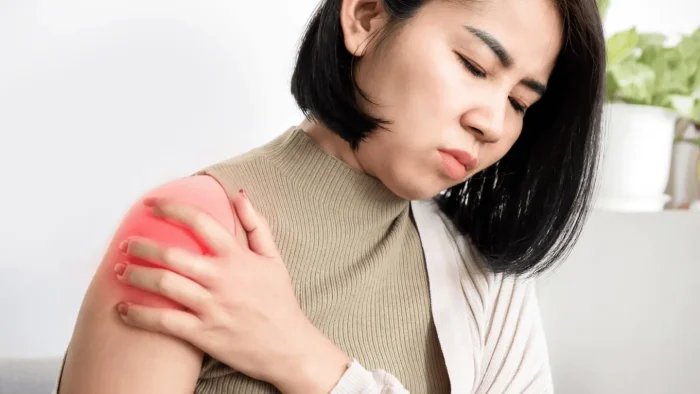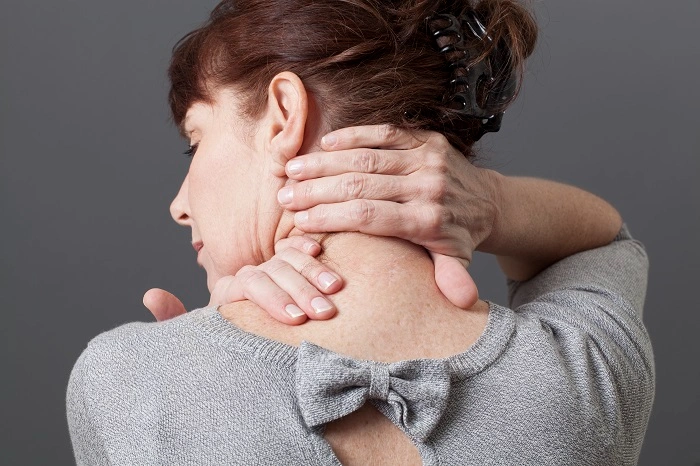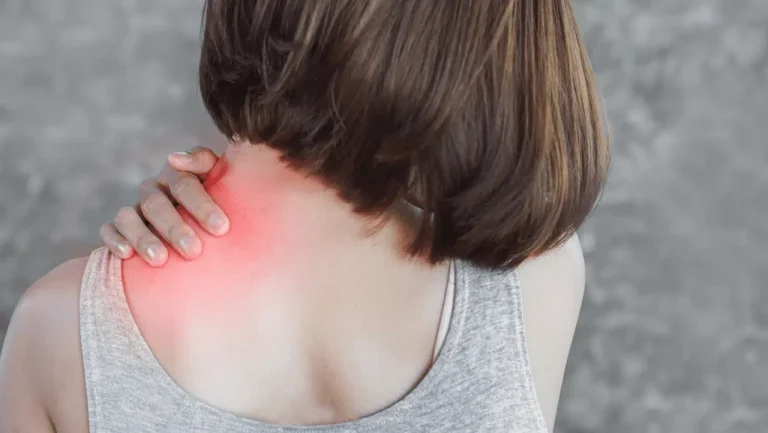She massages her shoulder. It won’t quit. It shoots up, into the back of her neck, sometimes down to the back of her head. She can’t help but wonder if it is work. If it is stressful. If it is more.
Woman pain in left neck and shoulder is more than a nuisance. For some, it’s a pulled muscle. For others, it’s a sign of disease that won’t wait. The body doesn’t always communicate. Sometimes it communicates in aches, stiffness, or stabs of pain.
Understanding the options puts at peace. It allows one to differentiate between what can be cured by posture and rest and what needs immediate therapy. This book covers all—cause, symptoms, danger, and cure—so all women experiencing this pain can walk with confidence and understanding.
Causes of Woman Pain in Left Shoulder and Neck Everyday

Muscle Strain
Muscles carry us along with them. Muscles cradle infants, lift groceries, pound out on typewriters in offices. They can become recalcitrant if overloaded with too much sudden effort or labor. A pulled tendon or strained muscle can introduce a throbbing, grinding ache across the shoulder and down the neck.
Poor Posture
Imagine posture as scaffolding. If it’s leaning, all the other things resting against it are as well. Slouching over a desk. Looking at a phone for hours on end. Hunched-up shoulders due to stress. These all cause muscles to contort into imbalance. The pain accumulates gradually but lingers.
Stress and Tension
Stress does not vanish. It seeps into the muscles. Women build it in the neck and shoulder region. Weight of responsibility becomes physical, the form of stiffness and pain.
Sleep Posture
Twisted neck due to a bad pillow. Shoulder pushed down onto the body. Waking up in pain is not uncommon when sleeping.
Injuries
Falling. Sports injuries. Car accidents. Even minor car accidents can lead to persistent pain in the left shoulder and neck. Whiplash injury is a common perpetrator, not always showing up until a few days following the accident.
More Subtle Medical Reasons
Arthritis
Joints deteriorate due to use and age. Arthritis of the neck or shoulder in women causes grinding, stiffness, and persistent pain. Grinding worsens with weather or continued activity.
Nerve Compression
Spine discs bulge, and muscles stretch, and nerves are squeezed. Pain shoots out from shoulder to neck, sometimes to arm or fingers. Numbness, weakness, or tingling follow.
Heart-Related Pain
The most life-threatening possibility. Women’s heart symptoms do not scream. They whisper. Dull ache in left shoulder and neck may be the only herald of heart attack or angina. Other symptoms—breathlessness, tiredness, nausea—may arrive unobtrusively.
Gallbladder and Referred Pain
Sometimes the pain doesn’t exist. Pain due to gallbladder or gastrointestinal illness can refer upwards, paying a visit to the left shoulder and neck.
Symptoms That Accompany Woman Pain in Left Neck and Shoulder
Localized Pain
Recurring, aching pain in the neck and shoulder aggravated by some movement typically points to muscles or joints.
Radiating Pain
Severe pain that radiates down the arm, into the jaw, or chest indicates nerve compression or cardiac issues.
Weakness and Numbness
Weakness, numbness, or heaviness of the left arm points to the attack on nerves—or a request for assistance from the heart.
Stiffness
Difficulty in turning the head. Difficulty in lifting the arm. Joints and muscles talk about arthritis or strain.
Systemic Symptoms
Sweating, dizziness, nausea, fatigue—when these are followed by shoulder and neck pain, the heart must be checked in a hurry.
Emotional Side of Pain
Pain is not only in the body. Pain crosses the mind. Pain in left shoulder and neck in women can trigger anxiety, especially when the heart might be the cause. It can put energy into work, caregiving, and daily functioning.
Aiding the emotional cost is recovery. Kind treatment, rest, and support rebalances.
When Woman Pain in Left Shoulder and Neck is a Warning

Red Flags for the Heart
- Pain referred to jaw, arm, or chest
- Sudden nausea or sweating
- Shortness of breath
- Pressure squeezing rather than stabbing pain
These are symptoms requiring immediate medical attention. Heart attack symptoms in women are nonspecific, but no less threatening.
Neurological Warnings
If pain is coupled with blurred vision, slurred speech, or dizziness on one side of the body, stroke could be the cause. BE FAST stroke awareness is indicated in this case.
Chronic or Progressive Pain
If pain persists beyond weeks despite rest and observation, more severe medical conditions such as arthritis or nerve compression should be considered.
How Doctors Diagnose
History and Questions
Physicians start with anecdotes. When did the patient first develop it? Why do they get it? Are there other symptoms? This history is the initial sketch.
Physical Exam
Range-of-motion examination. Palpation of the muscles and joints. Testing strength, reflexes, and sensation.
Imaging
- X-rays: to show joint issues or arthritis
- MRI or CT scans: to demonstrate nerves, discs, or occult trauma
- Ultrasound: for soft tissue injury
Heart and Blood Tests
In suspected heart trouble, EKGs, echocardiograms, or blood tests rule out or rule in damage.
Treatment Options
For Muscle and Posture Disorders
- Heat or cold treatment
- Gentle stretching
- Physical therapy
- Posture change at work and home
- Massage for contracted muscle
For Nerve Compression
- Anti-inflammatory medication
- Corticosteroid injections
- Directed physical therapy
- Surgery in bad cases
For Arthritis
- Medication for pain
- Regularity of exercise to maintain mobile joints
- Joint injections in bad cases
- Lifestyle changes for permanent pain relief
For Pain Due to Heart
- Emergency treatment if attack suspected
- Medications to restore flow
- Surgery or interventions like angioplasty when needed
Prevention Strategies
- Posture care: reposition chair, desk, and screen
- Breezy breaks: don’t spend long time in one place
- Tame stress: meditation, yoga, journaling
- Healthy lifestyle: healthy eating, weight control, and exercise
- Checkups: regular doctor visits to catch peril early
Living with Chronic Pain
For some, left shoulder and neck pain linger on. Coping with pain is a lifestyle.
Daily regular stretching with gentle care keeps muscles flexible.
Heat therapy eases tight joints.
Support groups promote emotional courage.
Counseling assists in the control of stress that comes with chronic pain.
Chronic pain does not dictate a woman’s life. It is only one strand in many—managed, familiar, carried with resilience.
Patient Stories
The Teacher
One teacher had a throbbing in her left shoulder and neck. She thought it was posture from grading papers. But when it moved to her jaw, she went to the ER. Doctors detected heart disease. Her quick action saved her life.
The New Mother
SUPPORTING HER BABY ON ONE SIDE OF HER BODY ALL DAY RESULTED IN MUSCLE TENSION EXTREME. Pain radiated into her neck and kept her awake. With a change in posture and physical therapy, she eliminated the pain.
The Runner
An individual training for her first marathon brushed off her shoulder ache. After some time, numbness in her arm made her aware of a pinched nerve. She recovered with therapy and was back stronger.
These stories remind us of the fact: every pain has a story to tell. And every story needs to be heard.
FAQs On Woman Pain in Left Shoulder and Neck
What is the most frequent cause of woman pain in left shoulder and neck?
The most frequent causes are muscle strain, poor posture, and stress.
Can cardiovascular diseases be the cause of this pain?
Yes. Women will feel heart-related pain as neck and left shoulder pain more than chest pain.
When should I go see a doctor?
If the pain is bad, constant, or with chest tightness, shortness of breath, or nausea.
Can stress really cause this type of pain?
Yes. Stress creates tension in muscles in the neck and shoulders, leading to constant pain.
What over-the-counter home remedies are effective?
Heat packs, stretching, massage, ergonomic adjustments, and stress control are the ticket.
Woman’s neck and left shoulder pain is not simply one story. It is several stories. It is sometimes stressful. Sometimes posture. Sometimes it is the heart. The problem is being a good listener. Being a good doer. Getting care when warning signs are an emergency.
Every woman must be made to take her pain seriously. To understand her body’s cry is important. To heal not just in medicine, but in sympathy, awareness, and strength.


